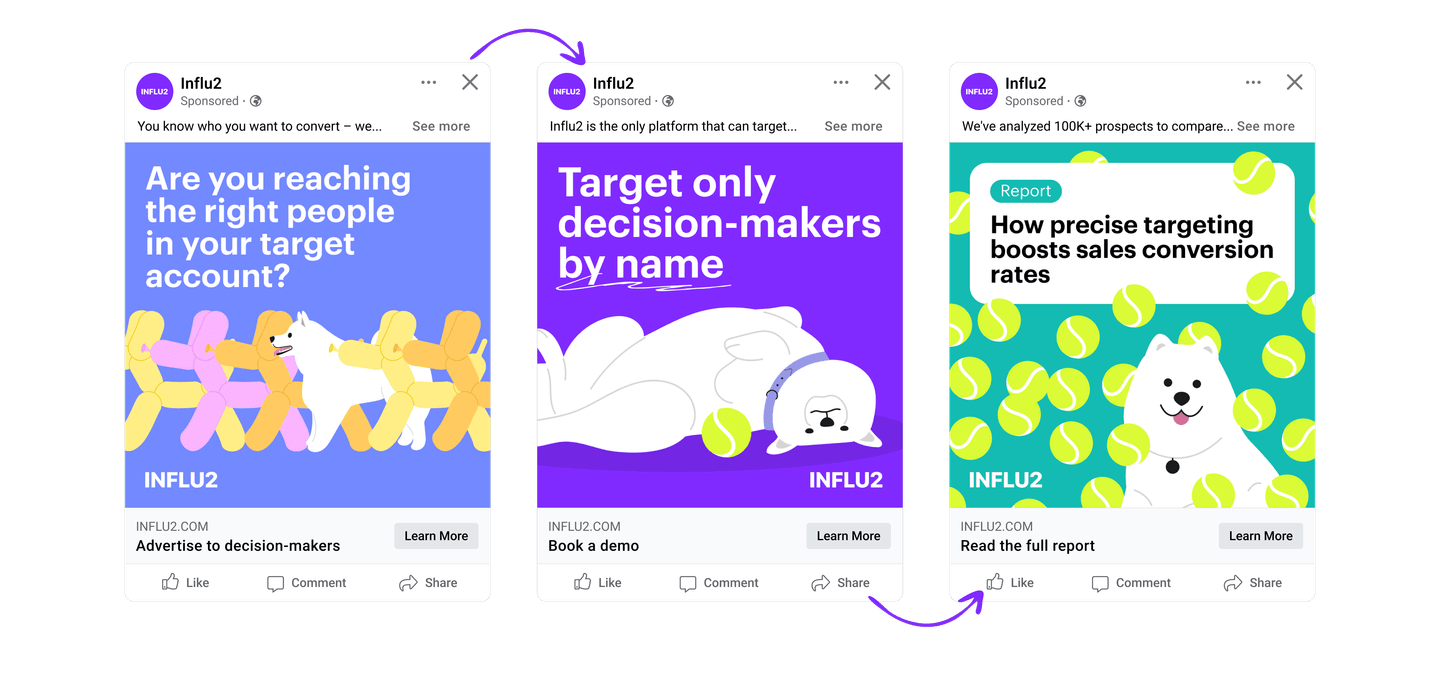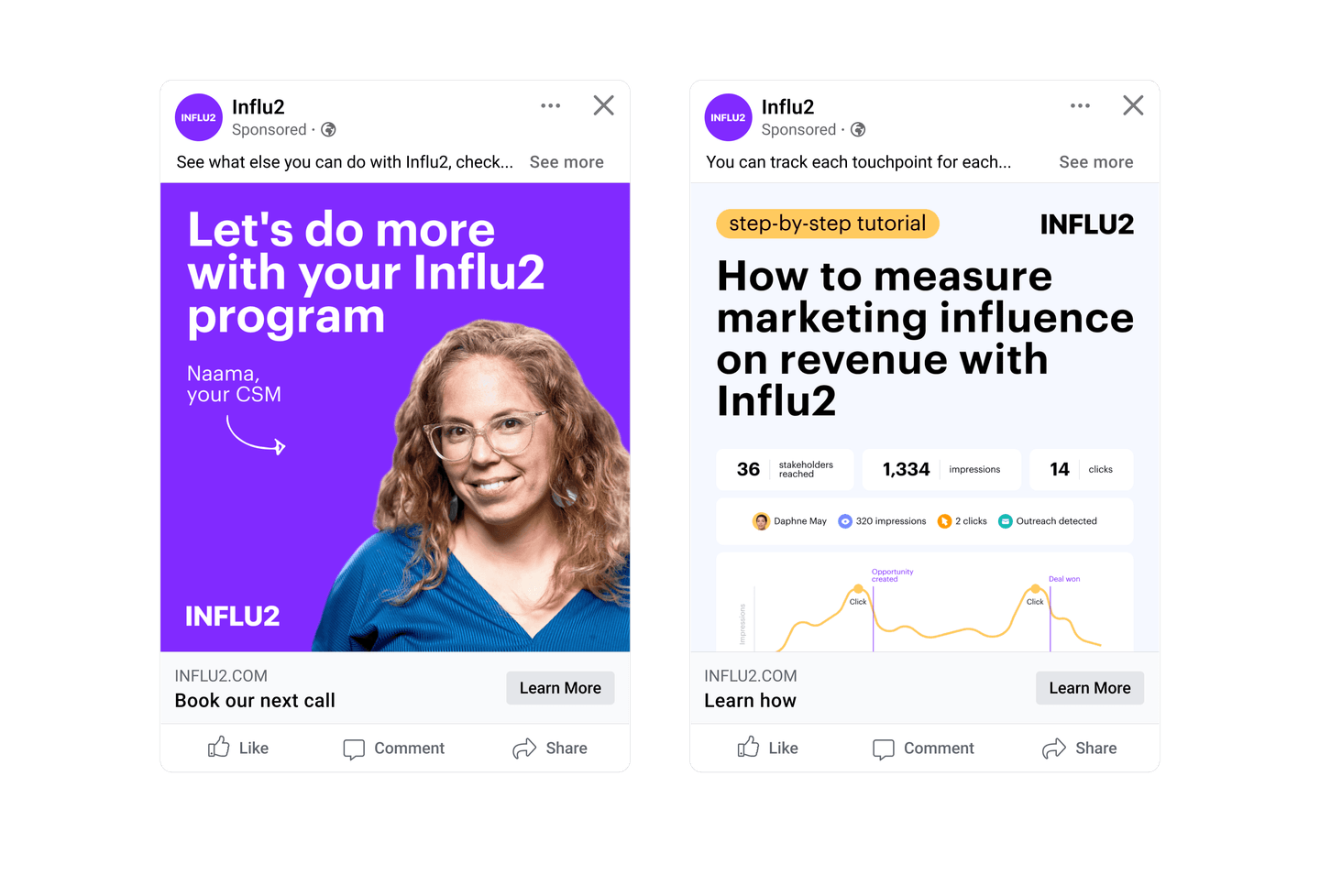Every marketer faces a constant challenge: how to create content that's relevant and personalized to each individual (and not drown in manual work along the way).
One approach is to adapt content based on industry and persona. This is a solid starting point. But it misses a crucial element: people navigate the buying journey at their own pace and respond to content in unique ways. If a user clicks on one ad or repeatedly views another, it only makes sense to present them with different, more relevant content based on their engagement.
So, how can we personalize content for each individual based on their interactions with it and the stage in the buying journey?
How to adapt ad content to the buyer journey
The number of decision-makers in high-value accounts can range from a dozen to a hundred. The ideal scenario is to engage everyone simultaneously and guide an account to a closed deal. But in reality, each person progresses through the buyer journey at their own speed. CMOs might be finishing your third case study, while CEOs would still remain unaware of your company's existence.
That’s why it makes more sense to tailor ads for each person based on their current journey stage. What’s also important is to consider buyers’ engagement with ads and use them for personalization. Clicks and impressions are actionable signals to move prospects to the next bunch of creatives. They show just how much information the prospects have already consumed and whether it resonated.
You can start with a core message that highlights a general value proposition, and then progressively add details as your prospects engage with ads. But that’s just the tip of it. Each value prop can be supported by various trust content pieces, case studies, and other custom campaigns.

There are many approaches to creating a custom buyer journey. For instance, you can align with sales on the key stages of the sales process and divide the journey into the three distinct units:
- Pipeline generation. Marketing works in lockstep with sales to engage buyers who have little to no knowledge of the company. They focus on educating prospects about the company's offering and driving them to a successful call.
- Deal closure. Once a prospect books a call and shows up to it, marketing works hand-in-hand with sales to move them through the sales pipeline. The process ends when the deal is closed.
- Post-sale expansion. After a successful deal closure, marketing doesn't stop. It plays a crucial role in supporting customer growth by helping them expand their usage of the product or service.
You can build upon this scheme to create more intricate journeys. The important thing here is that someone who just discovered your product will have vastly different needs than someone who already had a sales demo. So your ads should change accordingly.
Now, what kind of content can you show at each stage? Let’s look at some examples.
Examples of ad content for different journey stages
Pipeline generation
The goal here is to warm up your audience, build awareness and start conversations with potential customers who haven't heard of you or haven't considered your solution. It's about sparking an interest and making a connection.
At this stage, advertising adds yet another layer of personalization to sales communications. It also helps salespeople multithread more effectively and reach the target audience that is otherwise unreachable through email outreach.
We recommend mixing up the following types of content:
1. Value propositions. Clearly articulate the "why" behind your product or service. What problems do you solve? What benefits do you offer? Use a mix of regular informative ads and fun content that engages people on an emotional level.

2. Social trust. Show customer reviews, testimonials, and other types of social proof to support your value propositions with third-party feedback.

3. Thought leadership content. Offer industry insights, white papers, or webinars to better educate targets about your product.

4. Sales rep introduction. Build a personal connection by showing ads that introduce the same sales rep who is reaching out to a prospect via email. This way, it won’t be cold outreach anymore – their faces will be familiar already.

5. Demo show-up campaigns. After the call is booked, ads can also help you boost its attendance. Feature content that reminds attendees of an upcoming meeting and incentivizes attendance. Ads with personalized invitations from account executives can do the trick.

6. Demo no-show campaigns. Things can get in the way (and they usually do). If a prospect skipped an appointed date, target them with compelling content that will better explain what they missed. Outline the benefits they will get after booking another date for a demo.

Deal closure
The goal at this stage is to stay top-of-mind throughout the sales cycle that can last many months. Use ads to remind about your offer and show content that addresses potential concerns and objections. It’s also helpful to advertise to people who stopped responding to email outreach and re-engage them once again.
Ads should suit the specific stages of the sales cycle. At the beginning, it’s better to showcase thought leadership content, use cases, and case studies. As the cycle progresses, you can highlight content that helps build credibility or address potential deal blockers.
Here are some content types to consider:
7. Trust content. It also makes sense to show educational content to your buyers throughout the later stages of the journey. Such ads play a supporting role by providing valuable information that complements your more advanced ads.

8. Use cases. Illustrate how your product serves specific use cases and solves different problems for your prospects through various formats.

9. Case studies. Showcase how your product has helped other companies in specific industries, providing tangible proof of value.

10. Re-engagement campaigns to revive stalled opportunities. Rekindle interest with personalized ads offering valuable resources relevant to their past inquiries.

11. Objection-specific campaigns. You can use ads to address specific objections that your buyers expressed before. For instance, if they have any doubts regarding your product’s technology or price, you can advertise detailed explainers with technical details or ROI results from your other clients.

Post-sale expansion
There are even more revenue opportunities after the deal is won. That's why it's important for marketing to devote as much attention to the post-conversion stage of the journey. Content aimed at expansion should educate your existing customers while helping you identify their unique needs.
At this point, you can run product-focused campaigns like the following ones:
12. Adoption campaigns. Advertise additional resources like product tutorials, feature overviews, or how-to articles to ensure your customers know the full potential of your product.

13. New feature/add-on announcements. Identify upsell and cross-sell opportunities by sending targeted content that introduces new features or services. Use customers’ engagement with ads as signals of their interest.

14. Case studies from similar industries. Show your customers how similar companies are achieving their goals with your additional products/services. Adding a familiar face of their dedicated Customer Success Manager to the creative will help you build more trust.

Ads for all stages
15. Ad hoc campaigns. Don't limit yourself to these ideas though. You can use trust content and promote events, webinars, and any other initiatives at any stage of the journey. For instance, you can advertise your participation in relevant industry events to invite people to meet with you.

The technology to provide a personalized ad experience
So how do you make sure you show relevant content to each buyer at each journey stage?
The traditional ABM platforms allow you to move entire accounts through the journey. But if the goal is to provide a personalized ad experience to each buyer, this approach simply won’t do. As a contact-level ABM engine, Influ2 shows ads to specific people. This means that you can create custom journeys for different groups and automate ads swap for each person.
To ensure a smooth and automatic transition of prospects through journey stages, you can leverage two types of triggers in Influ2:
1. Influ2 ad engagement data. Influ2 tracks a user's interaction with your ads, including impressions, clicks, and landing page visits. This data helps you understand their level of engagement and current stage in the customer journey. For instance, if a prospect clicks on your theoretical guide and a few value props, it’s safe to assume they now require more advanced content. So it’s time to adjust ad creatives and show more information about specific case studies or use cases.
2. Data points from your CRM. Influ2 integrates seamlessly with your sales tools to gather additional context. The platform gathers info about email correspondence, CRM scores, new opportunities and their stages, won and lost deals, as well as other sales data points. This provides a deeper understanding of the target audience's specific needs and interactions with your sales team. For instance, an SDR has been sending outreach emails to a target. During this time, marketers can support sales prospecting by running ads with a personalized introduction of this SDR. It’s a great way to help sales build personal connections through other channels. Once a prospect agrees to a call, the ad content should evolve to the next stage – e.g. demo invites, case studies from similar industries, etc.
When creating journeys, you can combine the insights from Influ2 and your CRM system. This way, you can create personalized ad campaigns that effectively guide your target audience through each stage of the customer journey. And the whole process is 100% automated – you just need to add ad content for each journey stage, and the platform will adjust the creatives automatically based on the triggers you choose.
In conclusion
By setting triggers based on the prospect’s engagement signals and sales data points, you can deliver dynamic ad content that adapts to a buyer's journey stage. Imagine the possibilities: prospects receive ads that address their specific needs, shortening the sales cycle and boosting engagement.
Ready to take your personalization to the next level? Influ2 can help you automate buyer journeys and deliver personalized experiences at scale. Contact us today to learn more.







